Input interpretation

butyric acid
Chemical names and formulas
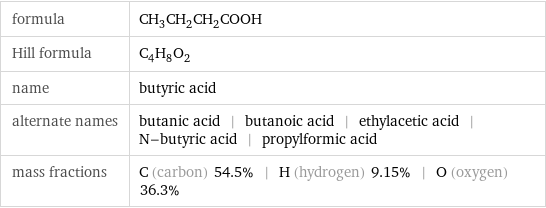
formula | CH_3CH_2CH_2COOH Hill formula | C_4H_8O_2 name | butyric acid alternate names | butanic acid | butanoic acid | ethylacetic acid | N-butyric acid | propylformic acid mass fractions | C (carbon) 54.5% | H (hydrogen) 9.15% | O (oxygen) 36.3%
Lewis structure
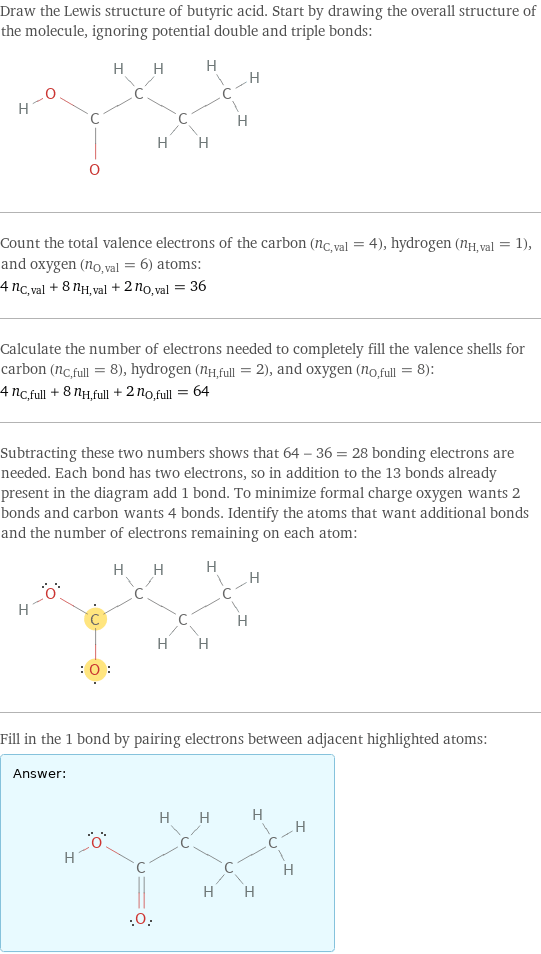
Draw the Lewis structure of butyric acid. Start by drawing the overall structure of the molecule, ignoring potential double and triple bonds: Count the total valence electrons of the carbon (n_C, val = 4), hydrogen (n_H, val = 1), and oxygen (n_O, val = 6) atoms: 4 n_C, val + 8 n_H, val + 2 n_O, val = 36 Calculate the number of electrons needed to completely fill the valence shells for carbon (n_C, full = 8), hydrogen (n_H, full = 2), and oxygen (n_O, full = 8): 4 n_C, full + 8 n_H, full + 2 n_O, full = 64 Subtracting these two numbers shows that 64 - 36 = 28 bonding electrons are needed. Each bond has two electrons, so in addition to the 13 bonds already present in the diagram add 1 bond. To minimize formal charge oxygen wants 2 bonds and carbon wants 4 bonds. Identify the atoms that want additional bonds and the number of electrons remaining on each atom: Fill in the 1 bond by pairing electrons between adjacent highlighted atoms: Answer: | |
3D structure

3D structure
Basic properties
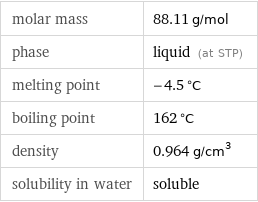
molar mass | 88.11 g/mol phase | liquid (at STP) melting point | -4.5 °C boiling point | 162 °C density | 0.964 g/cm^3 solubility in water | soluble
Units

Hydrophobicity and permeability properties

predicted LogP hydrophobicity | 0.78 experimental LogS | -0.19 predicted LogS | 0.43
Basic drug properties

approval status | experimental | small molecule drug categories | histamine antagonist
Liquid properties (at STP)
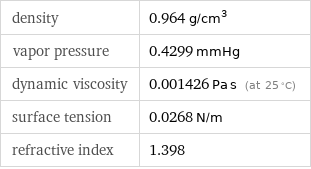
density | 0.964 g/cm^3 vapor pressure | 0.4299 mmHg dynamic viscosity | 0.001426 Pa s (at 25 °C) surface tension | 0.0268 N/m refractive index | 1.398
Units

Thermodynamic properties
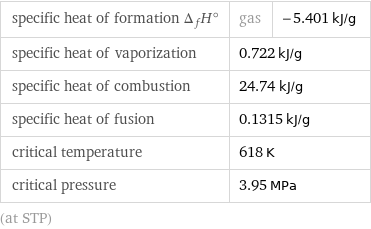
specific heat of formation Δ_fH° | gas | -5.401 kJ/g specific heat of vaporization | 0.722 kJ/g | specific heat of combustion | 24.74 kJ/g | specific heat of fusion | 0.1315 kJ/g | critical temperature | 618 K | critical pressure | 3.95 MPa | (at STP)
Units

Chemical identifiers
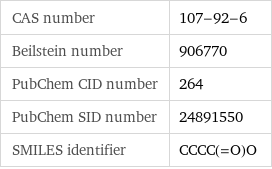
CAS number | 107-92-6 Beilstein number | 906770 PubChem CID number | 264 PubChem SID number | 24891550 SMILES identifier | CCCC(=O)O
NFPA label

NFPA label
Safety properties

flash point | 76.67 °C autoignition point | 425 °C lower explosive limit | 2% (concentration in air) upper explosive limit | 12.3% (concentration in air)
Toxicity properties

RTECS classes | mutagen | primary irritant